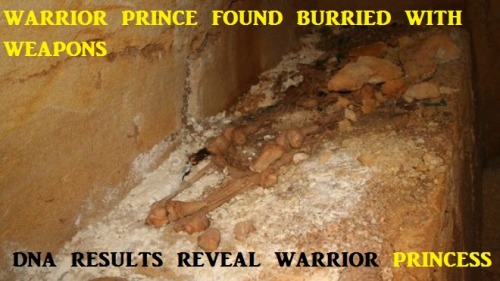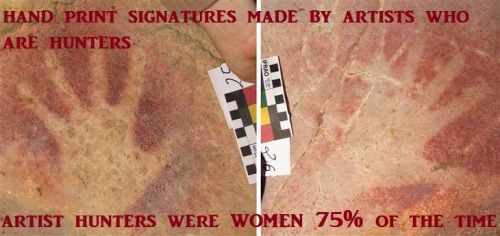thefingerfuckingfemalefury: logicalabsurdity: vsiorc: Skeleton thought to be Etruscan warrior prince
thefingerfuckingfemalefury:logicalabsurdity:vsiorc:Skeleton thought to be Etruscan warrior prince is actually a warrior princessPrehistoric cave prints show most early artists were womenso what feminists have been saying for years and years is true. women have always been involved in hunting, have been warriors and have made art. women have been inventors and made great discoveries… and women experts are finally breaking through the sexism to get the facts heard.“But bone analysis revealed the prince holding the lance was actually a 35- to 40-year-old woman, whereas the second skeleton belonged to a man.Given that, what do archaeologists make of the spear?"The spear, most likely, was placed as a symbol of union between the two deceased,” Mandolesi told Viterbo News 24 on Sept. 26.Weingarten doesn’t believe the symbol of unity explanation. Instead, she thinks the spear shows the woman’s high status.Their explanation is “highly unlikely,” Weingarten told LiveScience. “She was buried with it next to her, not him.”Gendered assumptionsThe mix-up highlights just how easily both modern and old biases can color the interpretation of ancient graves.In this instance, the lifestyles of the ancient Greeks and Romans may have skewed the view of the tomb. Whereas Greek women were cloistered away, Etruscan women, according to Greek historian Theopompus, were more carefree, working out, lounging nude, drinking freely, consorting with many men and raising children who did not know their fathers’ identities.Instead of using objects found in a grave to interpret the sites, archaeologists should first rely on bone analysis or other sophisticated techniques before rushing to conclusions, Weingarten said.“Until very recently, and sadly still in some countries, sex determination is based on grave goods. And that, in turn, is based almost entirely on our preconceptions. A clear illustration is jewelry: We associate jewelry with women, but that is nonsense in much of the ancient world,” Weingarten said. “Guys liked bling, too.”“had prints are cave-art signatures…"This is a surprise, since most archaeologists have assumed it was men who had been making the cave art. One interpretation is that early humans painted animals to influence the presence and fate of real animals that they’d find on their hunt, and it’s widely accepted that it was the men who found and killed dinner.But a new study indicates that the majority of handprints found near cave art were made by women, based on their overall size and relative lengths of their fingers."The assumption that most people made was it had something to do with hunting magic,” Penn State archaeologist Dean Snow, who has been scrutinizing hand prints for a decade, told NBC News. The new work challenges the theory that it was mostly men, who hunted, that made those first creative marks. Another reason we thought it was men all along? Male archeologists from modern society where gender roles are rigid and well-defined — they found the art. “[M]ale archaeologists were doing the work,” Snow said, and it’s possible that “had something to do with it.” “-MANIACAL LAUGHTER-I can’t stop giggling over how DESPERATE male archelogists are to try and make up some bullshit to explain away the idea of women being warriors and hunters in the past -- source link
Tumblr Blog : di-siorc-deactivated20140422.tumblr.com
#etruscans!#antiquariaetrusci#history#archaeology

